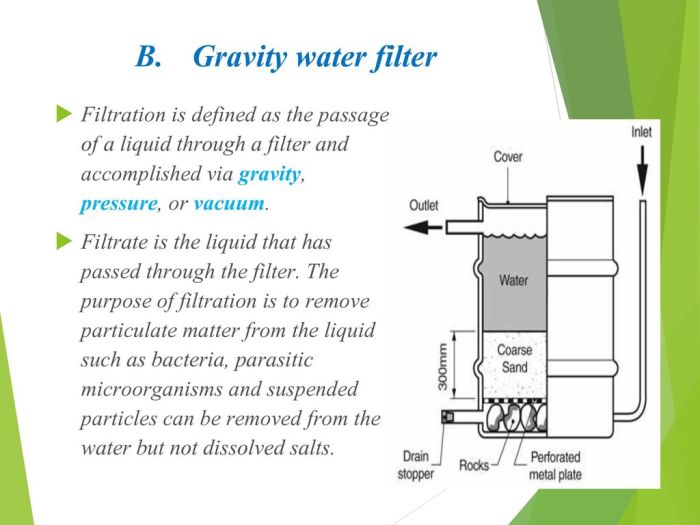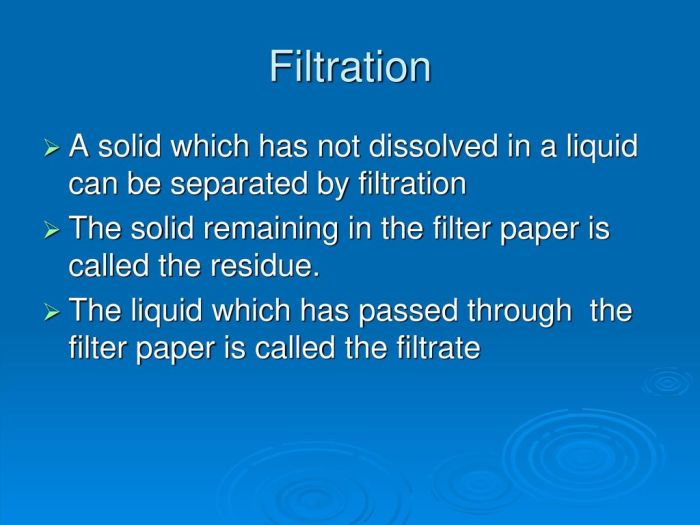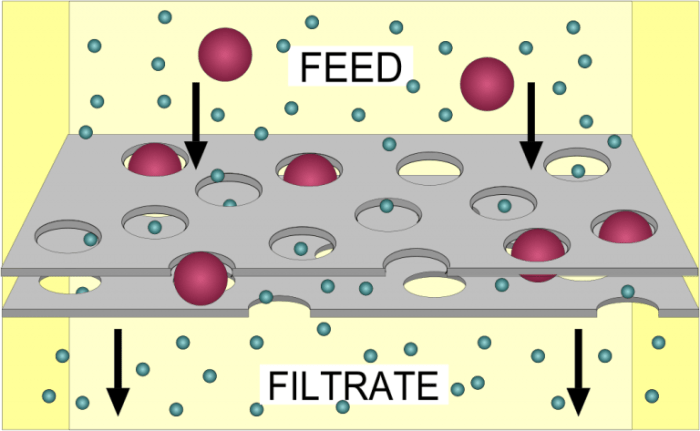Which of the following statements about filtrate is incorrect? This question delves into the realm of biological processes, examining the nature and characteristics of filtrate, a crucial component in various physiological systems. By exploring the misconceptions surrounding filtrate, we gain a deeper understanding of its significance and role in maintaining homeostasis.
Filtrate, a product of filtration, plays a vital role in regulating the passage of substances through membranes. Its composition, influenced by factors such as hydrostatic and osmotic pressure, provides valuable insights into physiological and pathological conditions. This article aims to clarify common misconceptions about filtrate, providing a comprehensive overview of its definition, characteristics, and clinical significance.
Filtrate Definition and Characteristics

Filtrate refers to the fluid that passes through a filter or semipermeable membrane, leaving behind retained substances. In biological systems, filtration is a crucial process that enables the selective passage of substances across membranes, regulating the composition of various body fluids and facilitating essential physiological functions.
The physical and chemical properties of filtrate vary depending on the nature of the membrane and the composition of the fluid being filtered. Generally, filtrate is characterized by:
- Low protein content due to the inability of large protein molecules to pass through most membranes
- High water content, as water molecules can freely permeate through membranes
- Variable ion composition, depending on the selectivity of the membrane and the electrochemical gradients across it
Examples of filtrate in biological systems include:
- Glomerular filtrate in the kidneys, which is the initial step in urine formation
- Capillary filtrate in the blood capillaries, which exchanges nutrients and waste products with interstitial fluid
- Synovial fluid in joints, which lubricates and nourishes the joint surfaces
Composition of Filtrate

The composition of filtrate reflects the selective nature of the filtration process and the concentration gradients across the membrane. In general, filtrate contains dissolved substances, ions, and molecules that are small enough to pass through the membrane pores or channels.
The composition of filtrate can vary significantly depending on the type of membrane and the specific biological context. For instance, glomerular filtrate in the kidneys is composed of water, electrolytes, glucose, amino acids, and waste products, while capillary filtrate contains a similar composition but with lower concentrations of proteins and larger molecules.
The following table compares the composition of filtrate with other bodily fluids:
| Component | Filtrate | Blood Plasma | Interstitial Fluid |
|---|---|---|---|
| Water | 99% | 92% | 93% |
| Sodium | 140 mEq/L | 140 mEq/L | 142 mEq/L |
| Potassium | 4 mEq/L | 5 mEq/L | 3 mEq/L |
| Chloride | 100 mEq/L | 103 mEq/L | 105 mEq/L |
| Glucose | 100 mg/dL | 100 mg/dL | 0 mg/dL |
| Protein | 0 g/dL | 7 g/dL | 2 g/dL |
These comparisons highlight the differences in composition between filtrate and other bodily fluids, reflecting the selective nature of filtration and its role in maintaining fluid balance and regulating the passage of substances through membranes.
Filtration Process and Mechanisms
Filtration is a physical process that involves the separation of particles or molecules based on their size and charge. In biological systems, filtration occurs across semipermeable membranes, which allow the passage of certain substances while retaining others.
There are two main types of filtration processes in biological systems:
- Glomerular filtration: Occurs in the kidneys and is the initial step in urine formation. Blood is forced through the glomerular capillaries, and the resulting filtrate is collected in the Bowman’s capsule.
- Capillary filtration: Occurs in the blood capillaries and involves the exchange of nutrients, waste products, and fluids between the blood and the surrounding tissues.
Both glomerular and capillary filtration are driven by a combination of hydrostatic and osmotic pressure gradients across the membrane. Hydrostatic pressure is the pressure exerted by the fluid, while osmotic pressure is the pressure exerted by dissolved particles in the fluid.
The following diagram illustrates the steps of glomerular filtration:
[Diagram of glomerular filtration, showing the blood entering the glomerular capillaries, the filtrate passing through the glomerular membrane into the Bowman’s capsule, and the retained substances remaining in the blood]
Understanding the mechanisms of filtration is essential for comprehending the physiological processes involved in fluid balance, waste elimination, and the regulation of solute concentrations in the body.
Clinical Significance of Filtrate: Which Of The Following Statements About Filtrate Is Incorrect
Filtrate analysis is a valuable tool in clinical medicine, providing insights into various physiological and pathological conditions. The composition of filtrate can reflect the function of the organs responsible for filtration, such as the kidneys and blood capillaries.
For example, abnormal levels of protein in the glomerular filtrate may indicate kidney damage or dysfunction, while changes in the electrolyte composition of capillary filtrate can suggest electrolyte imbalances or fluid retention.
Filtrate analysis is commonly used in the following clinical applications:
- Diagnosis and monitoring of kidney function: By analyzing the composition of glomerular filtrate, healthcare professionals can assess the glomerular filtration rate (GFR), which is an indicator of kidney function.
- Detection and management of electrolyte imbalances: Filtrate analysis can help identify and correct electrolyte imbalances, which can occur due to various factors such as dehydration, excessive fluid loss, or kidney dysfunction.
- Assessment of fluid balance: Filtrate analysis can provide information about fluid status and help guide fluid management in patients with conditions such as heart failure or kidney disease.
By understanding the clinical significance of filtrate, healthcare professionals can effectively utilize filtrate analysis to diagnose and manage a wide range of conditions, improving patient outcomes and overall health.
Misconceptions and Incorrect Statements about Filtrate

There are several common misconceptions or incorrect statements about filtrate that should be addressed:
- Filtrate is simply water: While filtrate primarily consists of water, it also contains dissolved substances, ions, and molecules that have passed through the filter or membrane.
- Filtration is a passive process: Filtration is an active process driven by hydrostatic and osmotic pressure gradients across the membrane.
- Filtrate composition is always the same: The composition of filtrate can vary depending on the type of membrane, the fluid being filtered, and the physiological context.
Understanding and correcting these misconceptions is important for accurate interpretation of filtrate analysis results and proper diagnosis and management of related conditions.
Detailed FAQs
What is the primary function of filtrate?
Filtrate plays a crucial role in regulating the passage of substances through membranes, ensuring the selective movement of molecules and ions.
How does filtrate differ from other bodily fluids?
Filtrate is distinct from other bodily fluids due to its unique composition, which is influenced by the specific filtration mechanisms involved.
What are the clinical applications of filtrate analysis?
Filtrate analysis finds applications in diagnosing and monitoring kidney function, providing insights into various physiological and pathological conditions.
